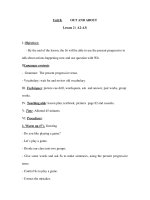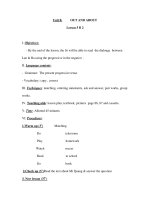LESSON 6 DAY BOOKS SALES AND
Bạn đang xem bản rút gọn của tài liệu. Xem và tải ngay bản đầy đủ của tài liệu tại đây (305.54 KB, 15 trang )
LESSON 6: DAY BOOKS: SALES AND
RETURNS DAY BOOKS
The objectives: After carefully studying this lesson, you should be able to:
1. appreciate the function of the purchases and sales day books; returns
inwards and returns outwards day books
2. recognise the invoice as the source document for credit purchases and
credit sales
3. recognise the credit note as the source document for returns entries
4. appreciate the accounting significance of trade discount and how this
contrasts with cash discount.
INTRODUCTION
You will learn how transactions are recorded in the purchases and sales day
books; how returns transactions are recorded in the Returns Inwards and
Returns Outwards day books and posted to the ledgers.
You will also learn about the invoice & credit note and how they are used
as source documents to write up these day books.
I.
SALES DAY BOOK
I.1. How to use the sales day book
A firm may sell
(a) completely for cash (including payment through a bank); or
(b) completely on credit; or
(c) partly for cash and partly on credit.
Cash sales are recorded by
-
debiting cash or bank (in the cash book)
-
crediting sales account (in the general ledger)
and this we will continue to do.
Credit sales are recorded in the sales day book, so that we are now modifying
the way in which, up to now, we have shown credit sale transactions.
I.1.1. Invoice
The basis of entry of credit sales is the invoice. This is known as a ‘source
document’- the point of reference for making an entry in the books of account.
The invoice is sent by the seller to the buyer. It gives details of the goods sold,
their prices, and the ‘term of sale’.
E.g.
INVOICE
Samantha & Company
15 West Street
Old bridge OQ16EP
3 May Year
5
Invoice No. XT 436
To: E Lyons
6 Wild Road
Bristol B6 4RN
Quantity
Description
Unit Price (£)
Total (£)
60
Boxes, square
5
300
40
Boxes, round
7
280
30
Bags
8
240
820
Less trade discount at
164
20%
656
Terms: 2½% cash discount
for payment within one month
Samantha & company, the seller, will keep one or more copies of the invoice.
From the copy sales invoice, the seller will make entries in the sales day book.
I.1.2. Trade discount
Trade discount is an allowance to traders for buying in big quantities.
A seller may offer 2 or 3 levels of trade discount (e.g. 15%, 20%, 25%..), with
those buying the biggest quantity obtaining the highest level of discount.
Trade discount is part of the agreement between the seller and the buyer of the
goods. So we do not record the trade discount in the accounts: we record the net
price only.
In contrast, cash discount is recorded in the accounts. Other conditions still have
to be met by the buyer/ debtor (payment by a certain date, in a suitable form of
payment) before (s)he has a right to the discount.
I.2. Characteristics of sales day book
Note: - Sales day book is know as a book of prime (original) entry where a
transaction is recorded for the first time, before posting to the Ledgers.
-
the Sales day book is a listing device only (a form of memorandum); it is
not part of double-entry system.
the entry in the day book is quite brief, there is no need to include a
-
description of the goods sold.
The form of the Sales day book is as follow, starting with the entry of the invoice
shown above:
Samantha & Company
SALES DAY BOOK
Year 5
Invoice No
Amount
(£)
May 3
E Lyons
XT 436
656
“
7
L Wallaby
XT 437
418
“
15
M Shawn
XT 438
835
“
23
T Merlin
XT 439
360
“
29
W Royal
XT 440
1,120
To Sales account
3,389
Note that, in the examination, you might not be provided with invoice numbers. If
so, you would omit that column, i.e. you would show three columns only.
Regarding the double-entry in the accounts:
(1) the ‘posting’ to the debtor accounts is made soon after the entry in the sales
day book: for one thing, it is desirable to keep the personal accounts as up-todate as possible;
(2) the total of credit sales for May Year 5 is transferred at the end of the month
to the credit of the sales account (in the General Ledger).
The accounts will appear thus:
SALES LEDGER
Dr
E Lyons
Year 5
May 3
(£)
Sales
Dr
656
L Wallaby
Year 5
May 7
(£)
Sales
Dr
418
M Shawn
Year 5
May 15
(£)
Sales
Dr
835
T Merlin
Year 5
May 23
(£)
Sales
Dr
360
W Royale
Year 5
May 29
Total £3,389 (Dr)
(£)
Sales
1,120
GENERAL LEDGER
Sales
Cr
Year 5
May 31
I.3. Advantages of having a sales day book
(£)
Sundries
3,389
* fewer items (transactions) have to be passed through the double-entry system
* the work of an accounts department can be divided up: one person can
maintain the day book while another can concentrate on the ledger.
I.4. Book of prime entry
Below is the structure of the Sales day book
Sales invoice
(= source document)
Sales Day Book
(= book of prime entry)
Promptly
Sales Ledger
(debtor accounts
debited)
II.
monthly transfer
General Ledger
(Sales account
credited)
PURCHASES DAY BOOK
II.1. How to use Purchases Day book
Cash purchases will continue to be recorded by
• debiting purchases account (in the general ledger)
• crediting cash or bank (in the cash book)
Credit purchases therefore will be recorded first in the Purchases Day book.
E.g. from the invoice shown in part I: Sales Day book, we can see that E Lyons is
the buyer; therefore the invoice will be recorded in the purchases day book of E
Lyons.
PURCHASES DAY BOOK
Year 5
Invoice No(*)
Amount
(£)
May 3
Samantha & Co
56/637
656
“
6
Tenerby & Sons
56/638
330
“
15
Wenderby & Platt
56/639
412
“
23
W Fisher
56/640
208
To Purchases account
1,606
(*) E Lyons would number each invoice as purchases are recorded in his system.
PURCHASES LEDGER
Samantha & Co
Year 5
May 3
(£)
Purchases
656
Tenerby & Sons
Year 5
May 6
(£)
Purchases
330
Wenderby & Platt
Year 5
(£)
May 15
Purchases
412
W Fisher
Year 5
(£)
May 23
Purchases
208
GENERAL LEDGER
Purchases
Year 5
May 31
(£)
Sundries
1,606
II.2. Book of prime entry
Below is the structure of the Purchases day book
Purchases Invoice
(= source document)
Purchases Day Book
(= book of prime entry)
Monthly transfer
General Ledger
(Purchases accounts
debited)
promptly
Purchases Ledger
(creditor accounts
credited)
III.
RETURNS DAY BOOKS
III.1. Returns Inwards Day book
For any reason, the buyer may return the seller the whole or part of the goods
previously bought. Then, the seller is making an allowance against the original
invoice. The source document for returns entries is Credit note, so called
because the seller will credit the account of the customer (debtor).
E.g. Refer to the Invoice in Part I, you will suppose that E Lyons returned some
of the goods on 9 May Year 5.
Samantha & Company
15 West Street
Old bridge OQ16EP
9 May Year
5
Credit Note No 6/57
To: E Lyons
6 Wild Road
Bristol B6 4RN
Quantity
30
Description
Bags
Unit Price (£)
Total (£)
8
240
240
Less trade discount at
48
20%
192
Samantha & Company would send the credit note to E Lyons and keep one or
more copies. All credit notes issued would be entered by Samantha & Company
in a Returns Inwards book, alternatively called Sales returns book.
From the day book,
• the items will be posted to the credit of customer accounts in the
sales ledger
• monthly (or other period) totals will be transferred to the debit of
returns inwards account in the general ledger.
The form of the Returns inwards day book, including the entry of the credit note
shown above, is as follow:
RETURNS INWARDS DAY BOOK
Year 5
Credit Note No
Amount
(£)
May 4
N Peters
6/56
64
“
9
E Lyons
6/57
192
“
21
M Shawn
6/58
220
To Returns Inwards account
476
The ledger entries will appear as follows:
SALES LEDGER
N Peter
Year 5
May 4
(£)
Returns inwards
64
E Lyons
Year 5
(£)
May 9
Returns inwards
192
M Shawn
Year 5
May 21
(£)
Returns inwards
220
GENERAL LEDGER
Returns Inwards
Year 5
May 31
(£)
Sundries
476
Below is the structure of Returns Inwards Day book
Credit Note issued
(= source document)
Returns Inwards Day Book
(= book of prime entry)
Monthly transfer
promptly
General Ledger
Purchases Ledger
(Returns Inwards accounts
(debtor accounts
debited)
III.2. Returns Outwards Day book
credited)
Credit Notes as received will be entered in a returns outwards day book (or
Purchases Returns book).
From the day book
• the items will be posted to the debit of customer accounts in the
purchases ledger.
• Monthly totals will be transferred to the credit of returns outwards
account in the general ledger.
RETURNS OUTWARDS DAY BOOK
Year 5
Credit Note No
(£)
May 3
T Walters
5378
86
“
9
Samantha & Co
6/57
192
“
24
Wilder & Co
446
116
To Returns Outwards account
The ledger entries will appear as follows:
PURCHASES LEDGER
T Walters
Year 5
May 3
(£)
Returns outwards 86
Samantha & Co
Year 5
May 9
(£)
Returns outwards 192
Wilder & Co
Year 5
(£)
394
Amount
May 24
Returns outwards 116
GENERAL LEDGER
Returns Outwards
Year 5
May 31
(£)
Sundries
394
Below is the structure of Returns Outwards Day book
Credit Note received
(= source document)
Returns Outwards Day Book
(= book of prime entry)
Promptly
Monthly transfer
Purchases Ledger
General Ledger
(Creditor accounts
(Returns outwards
accounts
debited)
credited)
SUMMARY
1. Cash sales and purchases are not entered in the day books.
2. When goods are sold on credit , the seller sends an invoice to the buyer; to the
seller it is a sales invoice and to the buyer it is a purchases invoice.
3. A trade discount is a reduction in the list prices of goods; trade discount is not
recorded in the accounts. Cash discount is recorded in the accounts.
4. The sales and purchases day books are not part of the double entry system;
they are just a listing of the credit transactions for the month.
5. The returns day books are not a part of the double entry system; they are just
a listing of the returns inwards and outwards for the month.
I hope you will be successful!
GLOSSARY
book of prime entry
(n)
Sổ gốc
credit note (n)
Giấy biên nhận hàng trả lại
day book (n)
Sổ nhật ký
invoice (n)
Hóa đơn
promptly (adv)
Ngay lập tức
purchases day book
(n)
Sổ nhật ký mua hàng
returns inwards day
book (n)
Sổ nhật ký hàng bán bị trả lại
returns outwards day
book (n)
Sổ nhật ký hàng mua trả lại
sales day book (n)
Sổ nhật ký bán hàng
trade discount (n)
Chiết khấu thương mại









